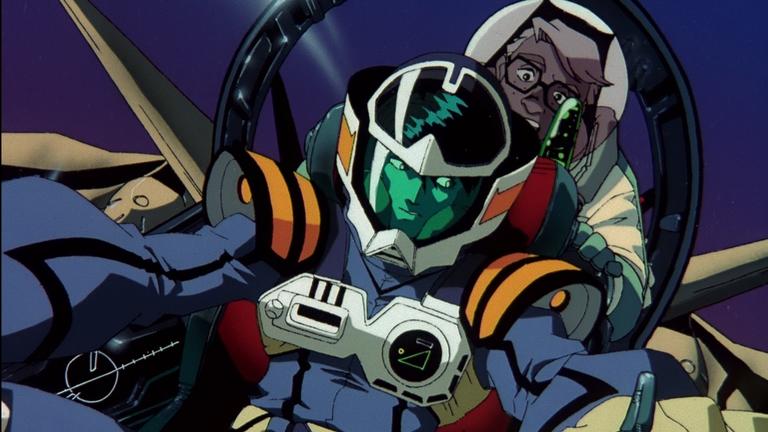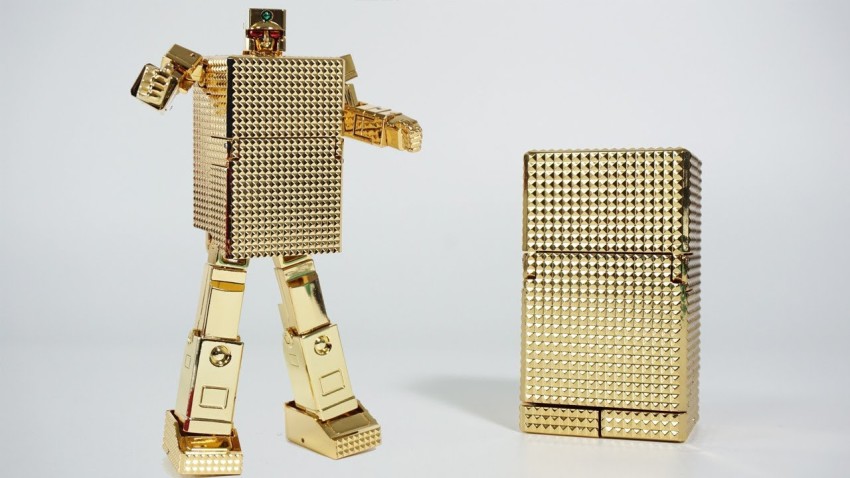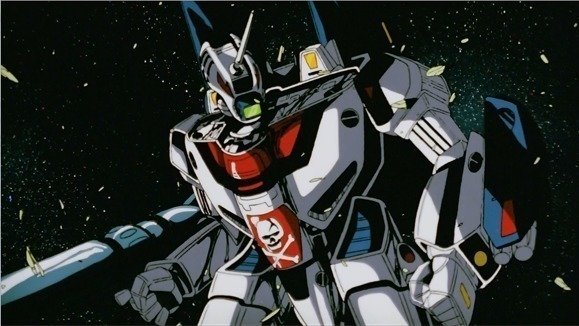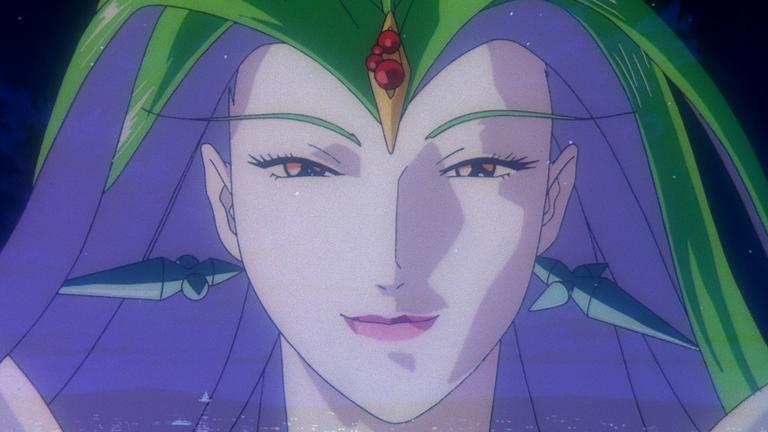Interview: Shoji Kawamori
November 6, 2019 · 0 comments
By Andrew Osmond.
 Shoji Kawamori is best known as one of the main creators of the Macross franchise, as well as having a plethora of creative credits on other anime. I interviewed him when he visited London in September as a guest at the Barbican’s “Anime’s Human Machines” season. While I focused particularly on Kawamori’s early career and the original Macross TV series, we also got on to Macross Plus, Vision of Escaflowne, Yoshiyuki Tomino and Kawamori’s contribution to Cowboy Bebop. Read on…
Shoji Kawamori is best known as one of the main creators of the Macross franchise, as well as having a plethora of creative credits on other anime. I interviewed him when he visited London in September as a guest at the Barbican’s “Anime’s Human Machines” season. While I focused particularly on Kawamori’s early career and the original Macross TV series, we also got on to Macross Plus, Vision of Escaflowne, Yoshiyuki Tomino and Kawamori’s contribution to Cowboy Bebop. Read on…
When you were at junior high school, you and your friends were so enthusiastic about Space Battleship Yamato that you tracked down the address of the people making it and visited the studio. That seems a remarkable thing to have managed when you were so young. What did you feel when you went there?
When I saw Yamato, I and my classmates were very hyped about it. One of my friends there, Mr Ogawa, researched in various places and found two studios that made Yamato. I and several friends went to Studio Nue. It had made a great piece of futuristic science-fiction; however, the studio itself was very small, very cluttered and very old! I was really shocked by the contrast. [Footnote: Kawamoto’s classmate Masaharu Ogawa went on to form the Ogawa Modeling Company, which provided effects for the 1989 live-action mecha film Gunhed.]
Was the visit a disappointing experience?
I was a little disappointed; however, it made me think that maybe I could do something (in anime) myself.
You then went on to work at Studio Nue even while you were still a student at high school and then at university. Many anime fans might think this was a wonderful situation, but you have talked about how you didn’t get proper credit for your work at this time.
 I didn’t get the credit even though I did a wide range of work; for example, animation on Gold Lightan (pictured), mecha design on Crusher Joe and Techno Police 21C, the planning and design on Macross, my work for Takara’s Diaclone series [the toy line that was the basis for Transformers in America], my work on an unmade project with Tomino called Asteroid One… I worked on them when I was still a student. My senior said, we cannot credit you on everything because you’ve done so many different kinds of work.
I didn’t get the credit even though I did a wide range of work; for example, animation on Gold Lightan (pictured), mecha design on Crusher Joe and Techno Police 21C, the planning and design on Macross, my work for Takara’s Diaclone series [the toy line that was the basis for Transformers in America], my work on an unmade project with Tomino called Asteroid One… I worked on them when I was still a student. My senior said, we cannot credit you on everything because you’ve done so many different kinds of work.
When you look back now, do you remember it as a good time?
It was very hard work, and my health was very bad, I had so many difficult experiences. But it was something that I wanted to do, I was highly motivated, so I kept going.
I wanted to ask about the original TV Macross in 1982. You were one of the main creators of the series; which were the main elements in Macross that were your own ideas?
In terms of mecha, I developed the Valkyrie with its “Super Pack” attachment and its armour. In terms of story, (I contributed) the town inside Macross and its regular citizens living there, the culture there, and the war being solved by song. I also did the story composition, before the scenario.
What time was Macross broadcast on Japanese television, and was it targeted at a particular age group?
It was shown at 2 p.m. on Sunday. The TV channels were thinking about that kind of thing (about demographics), but we were just making what we wanted to see.
Can you talk about the audience reaction to the original TV Macross when it was first shown? What did they respond to the most?
Some people said it was very interesting; others said they could not accept Minmay singing during the war.
You’ve said that Gundam fans had problems accepting the singing.
Do you think there was a rivalry between Gundam fans and Macross fans?
Maybe a slight cross-over. I was originally a big Gundam fan. The members of Studio Nue were also involved in the planning of Gundam; that’s why I wanted to make something totally different.
There’s one story that during the production of the TV Macross, an episode was actually left on a train; is this true?
Not a whole episode; maybe some animation cels. But we didn’t really have any trouble… But there was a time that we couldn’t make (a deadline) on time, so we had to make a recap episode.
Some of the situation in the story of Macross seemed to be a metaphor for Japan. For example, the human characters adapt and improvise alien technology, which reminded me of how postwar Japan prospered by developing and improvising on Western technology. Was that intentional?
That’s a very interesting question. Actually, people in Studio Nue often talked about the bakumatsu years [1853 to 1867], Japan’s transition from the Edo to the Meiji period after the Black Ships, when Japan quickly incorporated new technology.
 Also, there’s a memorable scene (part 5) where the whole Macross ship transforms for the first time, causing havoc for the refugees’ town. It feels very like an earthquake; was that deliberate?
Also, there’s a memorable scene (part 5) where the whole Macross ship transforms for the first time, causing havoc for the refugees’ town. It feels very like an earthquake; was that deliberate?
Actually, yes. Japanese people are used to those changes, earthquakes, volcanoes…
The original TV Macross was later reworked as the cinema film Do You Remember Love?, which you directed. Since then, you have been involved with several anime, such as Macross Plus, which have been released in different versions in different formats. Do you enjoy reworking stories and characters between formats?
I cannot bear (always) continuing within the same format. I really enjoy working between them, especially between the first Macross series and the film. I was able to change all the designs, which I enjoyed very much.
I also wanted to ask about Macross Plus. The story involves one character, Guld, who [SPOILER] has repressed a crucial memory. The memory is shocking – it turns out Guld sexually assaulted a female character, and possibly even raped her. Looking back at the scene, do you think it might have gone too far?
Macross Plus was made ten years after the first Macross. At the same time I was making Macross Plus, I was also making Macross 7, mainly targeted at teenagers. But in contrast, Macross Plus was made as an OVA for people who had seen the first Macross, who were now ten years older; therefore I didn’t have to worry about the content.
Macross Plus involves a virtual reality idol, Sharon Apple – what is your opinion of Hatsune Miku?
 I’d often talk about Sharon Apple, and all the fans going crazy over her, and the staff claimed that it was crazy, that it won’t happen. But then Hatsune Miku appeared and I could say I told you so! Hatsune Miku is a virtual idol but there is a person “inside.” [Miku’s voice is sampled from voice-actor Saki Fujita; in Macross Plus, Sharon Apple is linked to a human woman, Myung.] Those similarities were very interesting for me.
I’d often talk about Sharon Apple, and all the fans going crazy over her, and the staff claimed that it was crazy, that it won’t happen. But then Hatsune Miku appeared and I could say I told you so! Hatsune Miku is a virtual idol but there is a person “inside.” [Miku’s voice is sampled from voice-actor Saki Fujita; in Macross Plus, Sharon Apple is linked to a human woman, Myung.] Those similarities were very interesting for me.
Do you think Hatsune Miku is good or bad?
At the beginning, I felt quite awkward (about her), but they are making progress, improving her. The President of the company [presumably Hiroyuki Ito of Crypton Future Media] actually used to be an employee of the Satelight studio. [Satelight collaborated with Studio Nue on Macross Zero, Macross Frontier and Macross Delta].
I know you’ve said you’re unsure about this, but what are your current feelings about continuing the story of the characters in the original Macross, such as Hikaru and Minmay?
I sometimes run “simulations” in my head, but I’m still not sure if I should express them.
You have worked on some of the Gundam anime. I wondered if you have had many personal dealings with Yoshiyuki Tomino, and if so, how you would describe your working relationship – do you see each other as rivals?
When I was a student, I was a big fan of Mr Tomino’s work. I have only worked with him on the planning stages (of anime), but it was very stimulating. That’s why, as a fan, I want to make something very different from him.
How would you describe Mr Tomino’s personality?
Mr. Tomino is too unique to describe! He has a self-torturing aspect… Before getting to the main story, he has a long talk beforehand, saying, “If the situation is like this, then this happens; if there is this condition, then this happens…” If anything that he says in the beginning is missing, then you can take (the story) differently.
I wanted to ask about Vision of Escaflowne. The original concept for the series was yours, but other people influenced the production such as Mr Akane (director) and Mr Yuki (designer). Are you happy with how Escaflowne turned out?
I was very happy. I was involved with the story composition of the anime, and in a supervising position. They took my ideas very well, and Mr Akane added a samurai flavor; I think it blended well.
According to one source, you originally designed one of the main male characters, Allen, as a big, hunky character, but Mr Yuki made Allen more slender, more like a character from a shojo manga.
I cannot really remember; when I ordered character designs, I let the designer create them freely.
According to some sources, you were involved in Cowboy Bebop.
I attended the original concept meeting with Shinichiro Watanabe (who had co-directed Macross Plus) and Keiko Nobumoto (who’d scripted it).
Reportedly, you were involved in a memorable Cowboy Bebop episode in which the character Faye learns about her past (“Speak Like A Child”). It involved VHS and Betamax videotapes…
Yes, yes (laughs). I have five or six video players!
One of the series’ most moving scenes was where Faye sees her past self on the videotape – was that your idea?
I can’t really remember, but we were talking about that kind of thing in the concept meeting.
Thanks to the Barbican Centre for making this interview possible. Escaflowne and Cowboy Bebop are now streaming on All4.

Leave a Reply